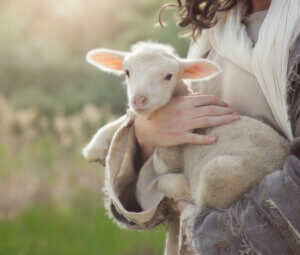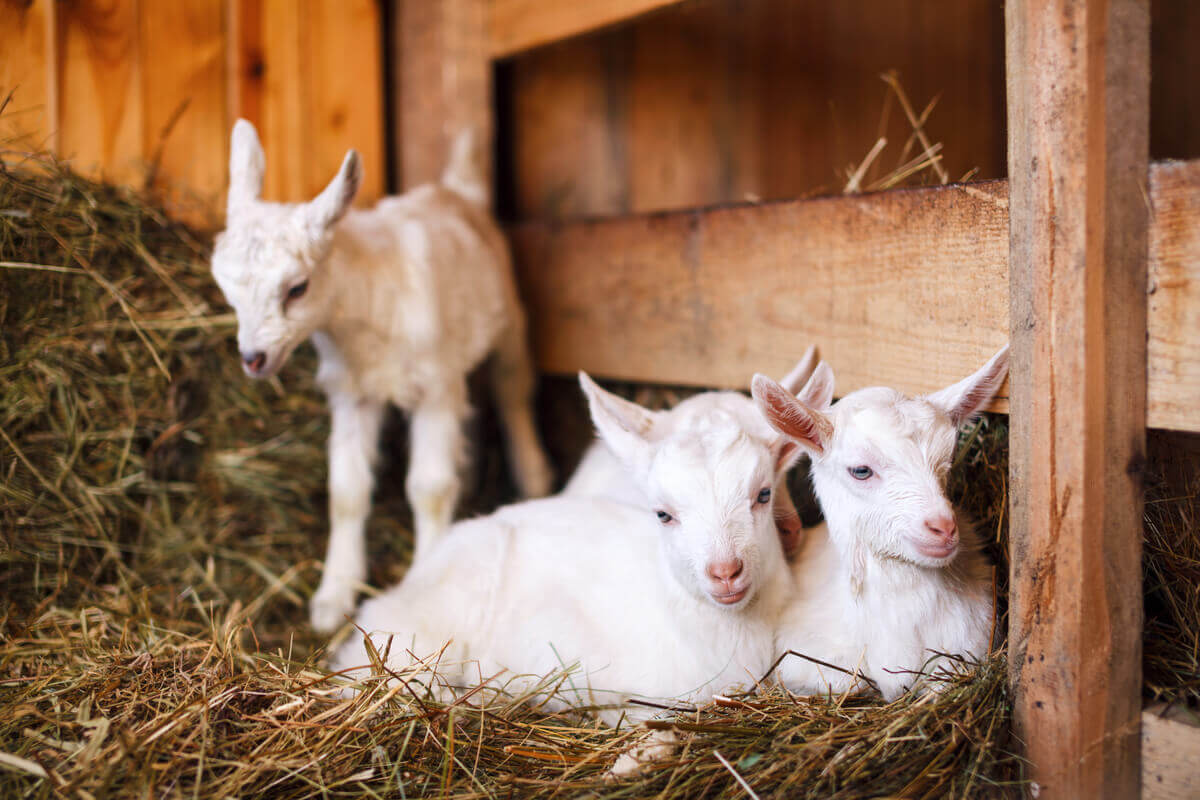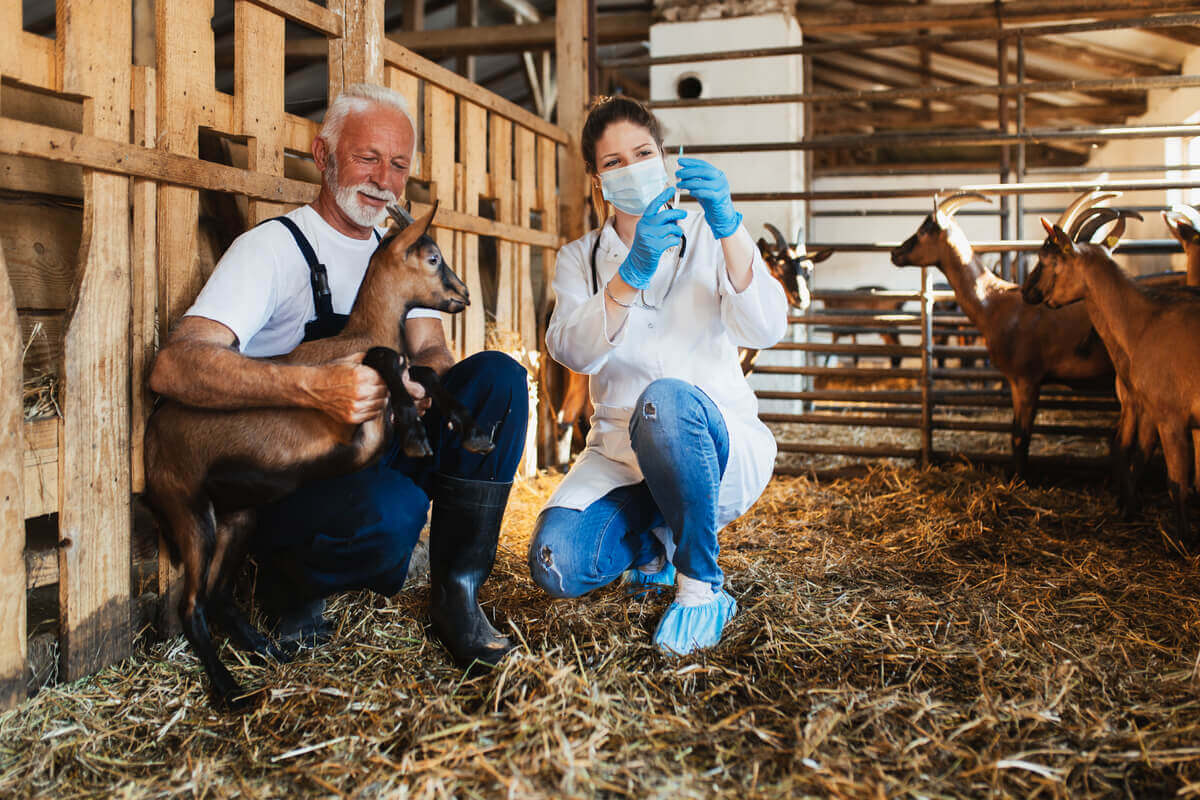Diarrhea in Small Ruminant Newborns


Written and verified by the vet Érica Terrón González
Diarrhea is one of the most common syndromes among small ruminant newborns, like those of sheep or goats, not to mention the severe losses due to the high mortality rates and stunted growth that it causes. Among the many agents that can cause this symptomatology, the parasite Cryptosporidium parvum is one of the most significant.
Cryptosporidiosis is a cosmopolitan disease that affects most vertebrate animals, as well as humans. What’s more, several studies show its growing and constant importance.
Cryptosporidiosis as the main cause of diarrhea in small ruminant newborns
Next, we’ll proceed to describe the most relevant particularities of this pathology and how it affects sheep and goats.

Cryptosporidium parvum and its epidemiology
We’re dealing with a protozoon, i.e. a microscopic parasite that invades the intestinal mucosa causing acute gastroenteritis. Newborns of small ruminant animals, who remain with their mothers – and other newborns in the same fold until the time comes for them to wean – ingest it unintentionally.
Thus, as soon as one individual is parasitized, transmission to other members of the fold is almost a sure thing. There are several factors that you must take into account because they favor the appearance of the infection. Among them, we find the following:
- Cryptosporidium produces a very high number of oocysts that the animals excrete with their feces.
- The infective dose – that is, the number of parasites that an animal must ingest to suffer the disease – is low.
- Oocysts can remain infectious for several months on the floor of livestock farms.
- The high number of lambs/kids on intensive production farms encourages transmission.
- Overcrowding and lack of hygiene among the animals are very harmful. It’s when hygienic conditions on a farm are poor that diarrhea outbreaks with high mortality occur.
- The presence of infected but symptom-free adult animals is a danger. They act as undetectable carriers.
Symptoms of neonatal diarrhea caused by C. parvum
Lambs and kids suffer infection during the first days of life and are especially receptive between the first and third week after birth. Immunological status appears to be a determining factor in the severity and duration of diarrhea.
This is because the immune system of these animals has yet to develop and hasn’t assimilated the defenses that maternal colostrum provides. What the farmer detects in these infected animals is the following:
- A sudden elimination of yellowish doughy feces, along with abdominal pain
- Apathy
- Dehydration
- Anorexia, responsible for growth retardation and weight loss in infected animals
These symptoms usually remit after 3-5 days. However, in the most severe cases, this situation can last up to 2 weeks, which greatly reduces the animals’ welfare as well as their value as livestock.
Diagnosis and treatment
Diarrhea in newborn calves can be due to multiple infectious agents. Therefore, it’ll be necessary to make a differential diagnosis, for example with Escherichia coli or Salmonella.
In vivo diagnosis involves detecting oocysts in the feces with a coprological analysis. In fact, the characteristics of oocysts require the use of more sophisticated techniques than routine analysis. Serological tests, on the other hand, have proven not to be useful in controlling the spread of the disease.
In terms of treatment, experts have evaluated many drugs for this disease. Most of them are only partially effective, as they reduce the number of parasites in the stool or the duration of the diarrheal episode.
These drugs usually go hand in hand with those that treat the symptoms to restore the animals from dehydration and weight loss.
Control and prevention of diarrhea in small ruminant newborns caused by C. parvum
In the absence of specific drugs against cryptosporidium, it’s best to resort to control and prevention techniques. The first of these is vaccination, but the truth is that not much progress has yet been made in small ruminants. Therefore, prophylactic measures related to hygiene and biosecurity are necessary:
- It’s advisable to separate infected animals from healthy ones, providing them with clean housing and renewing the straw to avoid accumulation of feces.
- Avoid overcrowding by reducing the density of newborn animals in delivery areas and by separating animals into batches.
- Farmers should also clean and disinfect pens using disinfectants. Females about to give birth should do so in areas that haven’t been occupied by infected newborns.
- Colostrum in sufficient quantity and quality must be provided to the lambs/kids during the first 6 hours of life.

The significance of diarrhea in small ruminant newborns
Cryptosporidium parvum is postulated as the main causal agent of neonatal diarrhea syndrome in sheep and goats. Despite its high incidence, neither specific treatment nor an effective vaccine is yet available to all farmers.
This is why hygiene and biosecurity measures are implemented on farms. Finally, account must be taken of the zoonotic nature of this disease and the possible transmission to people in contact with infected animals.
Diarrhea is one of the most common syndromes among small ruminant newborns, like those of sheep or goats, not to mention the severe losses due to the high mortality rates and stunted growth that it causes. Among the many agents that can cause this symptomatology, the parasite Cryptosporidium parvum is one of the most significant.
Cryptosporidiosis is a cosmopolitan disease that affects most vertebrate animals, as well as humans. What’s more, several studies show its growing and constant importance.
Cryptosporidiosis as the main cause of diarrhea in small ruminant newborns
Next, we’ll proceed to describe the most relevant particularities of this pathology and how it affects sheep and goats.

Cryptosporidium parvum and its epidemiology
We’re dealing with a protozoon, i.e. a microscopic parasite that invades the intestinal mucosa causing acute gastroenteritis. Newborns of small ruminant animals, who remain with their mothers – and other newborns in the same fold until the time comes for them to wean – ingest it unintentionally.
Thus, as soon as one individual is parasitized, transmission to other members of the fold is almost a sure thing. There are several factors that you must take into account because they favor the appearance of the infection. Among them, we find the following:
- Cryptosporidium produces a very high number of oocysts that the animals excrete with their feces.
- The infective dose – that is, the number of parasites that an animal must ingest to suffer the disease – is low.
- Oocysts can remain infectious for several months on the floor of livestock farms.
- The high number of lambs/kids on intensive production farms encourages transmission.
- Overcrowding and lack of hygiene among the animals are very harmful. It’s when hygienic conditions on a farm are poor that diarrhea outbreaks with high mortality occur.
- The presence of infected but symptom-free adult animals is a danger. They act as undetectable carriers.
Symptoms of neonatal diarrhea caused by C. parvum
Lambs and kids suffer infection during the first days of life and are especially receptive between the first and third week after birth. Immunological status appears to be a determining factor in the severity and duration of diarrhea.
This is because the immune system of these animals has yet to develop and hasn’t assimilated the defenses that maternal colostrum provides. What the farmer detects in these infected animals is the following:
- A sudden elimination of yellowish doughy feces, along with abdominal pain
- Apathy
- Dehydration
- Anorexia, responsible for growth retardation and weight loss in infected animals
These symptoms usually remit after 3-5 days. However, in the most severe cases, this situation can last up to 2 weeks, which greatly reduces the animals’ welfare as well as their value as livestock.
Diagnosis and treatment
Diarrhea in newborn calves can be due to multiple infectious agents. Therefore, it’ll be necessary to make a differential diagnosis, for example with Escherichia coli or Salmonella.
In vivo diagnosis involves detecting oocysts in the feces with a coprological analysis. In fact, the characteristics of oocysts require the use of more sophisticated techniques than routine analysis. Serological tests, on the other hand, have proven not to be useful in controlling the spread of the disease.
In terms of treatment, experts have evaluated many drugs for this disease. Most of them are only partially effective, as they reduce the number of parasites in the stool or the duration of the diarrheal episode.
These drugs usually go hand in hand with those that treat the symptoms to restore the animals from dehydration and weight loss.
Control and prevention of diarrhea in small ruminant newborns caused by C. parvum
In the absence of specific drugs against cryptosporidium, it’s best to resort to control and prevention techniques. The first of these is vaccination, but the truth is that not much progress has yet been made in small ruminants. Therefore, prophylactic measures related to hygiene and biosecurity are necessary:
- It’s advisable to separate infected animals from healthy ones, providing them with clean housing and renewing the straw to avoid accumulation of feces.
- Avoid overcrowding by reducing the density of newborn animals in delivery areas and by separating animals into batches.
- Farmers should also clean and disinfect pens using disinfectants. Females about to give birth should do so in areas that haven’t been occupied by infected newborns.
- Colostrum in sufficient quantity and quality must be provided to the lambs/kids during the first 6 hours of life.

The significance of diarrhea in small ruminant newborns
Cryptosporidium parvum is postulated as the main causal agent of neonatal diarrhea syndrome in sheep and goats. Despite its high incidence, neither specific treatment nor an effective vaccine is yet available to all farmers.
This is why hygiene and biosecurity measures are implemented on farms. Finally, account must be taken of the zoonotic nature of this disease and the possible transmission to people in contact with infected animals.
All cited sources were thoroughly reviewed by our team to ensure their quality, reliability, currency, and validity. The bibliography of this article was considered reliable and of academic or scientific accuracy.
- Sánchez Acedo C, Quílez Cinca J, del Cacho Malo E, Gallego Valcarce M, López Bernad F, Estrada Peña A. Diarreas neonatales de los pequeños rumiantes: criptosporidiosis [Internet]. Zaragoza: Departamento de Patología Animal. Parasitología y Enfermedades Parasitarias. Facultad de Veterinaria. Universidad de Zaragoza; 2009 [cited 25 November 2020]. Available from: http://produccion-animal.com.ar/sanidad_intoxicaciones_metabolicos/enfermedades_caprinos/34-criptosporidiosis.pdf
- Cryptosporidium parvum [Internet]. Es.wikipedia.org. [cited 25 November 2020]. Available from: https://es.wikipedia.org/wiki/Cryptosporidium_parvum
- Guía de buenas prácticas de higiene en Vacuno y OvinoCaprino [Internet]. Mapa.gob.es. [cited 12 December 2020]. Available from: https://www.mapa.gob.es/es/ganaderia/publicaciones/practicas-vacuno.aspx
- Ooquiste [Internet]. Es.wikipedia.org. [cited 25 November 2020]. Available from: https://es.wikipedia.org/wiki/Ooquiste#:~:text=En%20biolog%C3%ADa%20y%20parasitolog%C3%ADa%2C%20un,cigoto%20de%20un%20par%C3%A1sito%20apicomplexo.
This text is provided for informational purposes only and does not replace consultation with a professional. If in doubt, consult your specialist.








